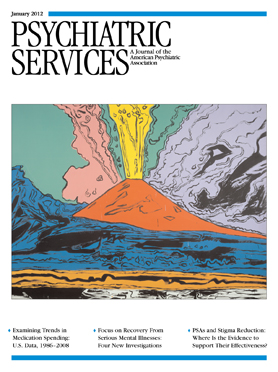Risk and Recovery Group for Offenders With Mental Disorders
Implementation of the recovery model in secure mental health environments has proved a challenge because of the inherently coercive nature of being hospitalized involuntarily. Once a week for the last three years, we have been running an open-ended, hour-long therapeutic group program for offenders with mental disorders in a 26-bed medium-security rehabilitation unit in inner-city London. It is called the HCR-20 Risk and Recovery Group and is one way of bringing recovery principles into such environments.
The HCR-20 Risk Assessment for Violence (HCR-20) is a well-known structured professional assessment tool. It uses 20 confirmed risk factors for future violence and separates them into ten historical, five clinical, and five risk items for rating as present, partially present, or absent. The therapeutic group was developed as a way to use the HCR-20 to facilitate discussion about risk. This promotes transparency about the treating team's assessment of patients' risk to others and encourages participants to take responsibility for managing their own risk factors, ultimately reducing their risk. Attendance is voluntary and open to all inpatients and clinical staff on the unit.
Two main formats are used to promote engagement and discussion. First, participants are provided short vignettes about a fictional patient and a copy of the HCR-20, which includes a few descriptive sentences under each of its 20 checklist items. The manual's descriptions for each item have been simplified to a few clearly written sentences to enhance understanding. In a way that models the treating team's decision making, the group then goes through each item, referring to the item descriptor each time. All attendees, both patients and staff, are asked how they would score each item and their reasons for it. Differences of opinion can often lead to heated discussions among attendees. Once everyone has expressed an opinion, a vote is taken, and the score that receives the most votes is recorded. Once all 20 items have been scored and summarized in a single table, each participant must assess the fictional patient's overall risk (high, medium, or low) and whether or not the person is ready for a short-term leave from the unit, transfer to a lower-security unit, or discharge to the community. It has been observed that the group's decisions conform very closely to the clinical team's decisions based on the same scores.
The second format is to, with the patient's permission, review individual HCR-20 risk assessments with the group. Each participant is given complete control over how much of his or her past (historical items) is disclosed to the group, including details of the index offense. This is partly to meet confidentiality requirements but also to reinforce with patients that their past cannot be changed and that they need to focus on the present (clinical items) and future (risk items) to ensure discharge and future safety in the community. Fellow patients can comment on clinical items, given that they live with each other in close quarters for lengthy periods of time; the average length of stay is 18 months. It is also useful to have patients who are further along their recovery journey than others (and therefore less risky) because they can advise and support peers directly—a process likely to have a greater impact than hearing suggestions directly from the facilitators.
The program instills hope among participants that they can progress from their hospitalization and helps them gain a better understanding of the relationship between mental illness, risk, and the reasons for their continued detention. In addition, it provides a rationale for various rehabilitation strategies in which patients are asked to engage, such as family therapy for those who score highly on the item relating to lack of personal support (R3) or substance abuse treatment for those for whom drugs are potential destabilizers (R2). Perhaps most important, it informs patients about what they need to do in order to be discharged and ensures that their goals remain in focus.
Finally, there are now graduates of the HCR-20 Risk and Recovery Group—patients who previously attended and have moved on to conditions of lower security or direct discharge to the community. They act as expert cofacilitators and represent a very powerful way of engaging even the most resistant patient. In order to fully implement the recovery vision, there are future plans for the program to be run by the patients themselves.



